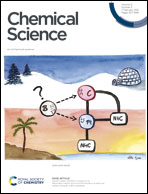Ritter-enabled catalytic asymmetric chloroamidation of olefins†
Abstract
Intermolecular asymmetric haloamination reactions are challenging due to the inherently high halenium affinity (HalA) of the nitrogen atom, which often leads to N-halogenated products as a kinetic trap. To circumvent this issue, acetonitrile, possessing a low HalA, was used as the nucleophile in the catalytic asymmetric Ritter-type chloroamidation of allyl-amides. This method is compatible with Z and E alkenes with both alkyl and aromatic substitution. Mild acidic workup reveals the 1,2-chloroamide products with enantiomeric excess greater than 95% for many examples. We also report the successful use of the sulfonamide chlorenium reagent dichloramine-T in this chlorenium-initiated catalytic asymmetric Ritter-type reaction. Facile modifications lead to chiral imidazoline, guanidine, and orthogonally protected 1,2,3 chiral tri-amines.



 Please wait while we load your content...
Please wait while we load your content...